


 |  |  |
|---|
| ||
|---|---|---|
 Abaddon is the name of the red planet, the fifth planet from the sun, and a neighbor of Sinai. It is associated with war and also with the element of Fire, and hence is very important to the Sphere of Fire of the College Esoterica. Abaddon has a single moon, Sheol, which is as red as it is. Abaddon is the name of the red planet, the fifth planet from the sun, and a neighbor of Sinai. It is associated with war and also with the element of Fire, and hence is very important to the Sphere of Fire of the College Esoterica. Abaddon has a single moon, Sheol, which is as red as it is. For a long time, Abaddon was believed to be lifeless and cold, covered with rusty sands, and criss-crossed with strange "canals". There are many areas on the surface with active volcanos, bubbling hot springs, and vents that let noxious vapors seep into the atmosphere. The truth is that Abaddon is indeed capable of sustaining life, though not as well as Sinai by any means. At least in one area of Abaddon, there are several scattered colonies of races that parallel many prominent on Sinai, living in artificial "Life Domes", and with a higher level of technology that allows them the use of machines that would not be considered possible -- or safe -- on Sinai. The canals do indeed hold water and vegetation, but also are infested by disease and hostile creatures (such as the "Rotbiter") that make them far too dangerous to utilize by most. In recent history (during the first year of the reign of Tahir Archelaus the First), a (relatively) small chunk of the Himar region (including the city of Elamoore) was transplanted by some sort of Exile technology onto Abaddon, resulting in the fertile "Pit of Himar" that may some day be the site of the largest Life Dome of all. Already, the combined efforts of several tribes on Abaddon have resulted in the Pit of Himar being spanned by a massive framework, slowly being covered against the inhospitable elements, and fitted with environmental controls. Abaddon is very rich in metals, and Abaddonian iron is a popular commodity on metal-scarce Sinai. Abaddonian metal that has recently been brought to Sinai is known to have magic-resistant properties, though it has been observed that this slowly degrades as the metal "acclimates" to Sinai. This phenomenon does not seem to apply to all metal brought in from other worlds, though it is still very common - It is well known that meteoric iron has certain anti-magic properties, after all. Access to the world of Abaddon is provided by an ancient Sifran structure known as the Gateway Tower. The Gateway Tower on Abaddon is within the domain of the human-dominated Kampfzengruppe, allied with the Khattan Emirate for its control. "Abaddon" is also the name of the God of War, Fire and Destruction in the Olympian mythos. | ||
| ||
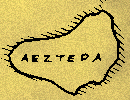 An ancient island-nation, now considered a lost civilization, off the southern coast of the continent of Ur, and believed to be mostly covered by a Forbidden Zone (one which some scholars have theorized may have actually expanded to cover the entirety of this large island). Little is known for sure about the Aeztepans, although obscure legends and more recent research indicate that they were a race of spotted felines, bearing some superficial resemblance to Terran creatures known as "jaguars". The language persists in scholarly circles only in its written, hieroglyphic form. However, "secrets of Aeztepa" are often invoked in mystical and less-reputable magical circles, as it is often believed that these ancient peoples held some sort of great secrets ... though those same secrets supposedly turned their land into what it is now known as the Land of the Dead. An ancient island-nation, now considered a lost civilization, off the southern coast of the continent of Ur, and believed to be mostly covered by a Forbidden Zone (one which some scholars have theorized may have actually expanded to cover the entirety of this large island). Little is known for sure about the Aeztepans, although obscure legends and more recent research indicate that they were a race of spotted felines, bearing some superficial resemblance to Terran creatures known as "jaguars". The language persists in scholarly circles only in its written, hieroglyphic form. However, "secrets of Aeztepa" are often invoked in mystical and less-reputable magical circles, as it is often believed that these ancient peoples held some sort of great secrets ... though those same secrets supposedly turned their land into what it is now known as the Land of the Dead.The whole island is considered quarantine under authority of both Rephidim and of Babel, and travellers give it a wide berth, especially since freak storms have a tendency to pop up in the area. | ||
| The Sanctuary of Amber is a monastery built for use by the Order of the Bounded Star and Anchor, situated in the Forbidden Zone of Shabar. The structure itself is suspended amongst several stone "needles" that characterize this strange region, and is of unknown age or means of construction. It is believed that the structure is actually built upon a "natural" formation (possibly a relic of the Sifras). The Sanctuary of Amber is noteworthy for its central chamber, in which it is believed that certain well-tuned minds may, from time to time, receive visions of possible futures -- particularly disasters to be hopefully averted with the warning given. On Ring Day, 6103 RTR, Shabar declared its independence from Rephidim, having formerly been a protectorate. Thus, the Sanctuary of Amber (also known as just "Amber") is recognized as the capitol of Shabar. | ||
| ||
| (not common knowledge outside of Ur and religious circles) In the mythos of the Gigi, Amena is the dark goddess, who is the enemy of their primary goddess, Nala. Amena is associated primarily with death, but particularly with undeath, leading suppositions that she may actually be related to the concept of Amenlichtli, the "Queen of the Undead". (Also, the duality relationship between Nala and Amena -- combined with the similarity on the name "Nala" with goddesses such as Inala, Sunala, Rinala and Dinala -- may suggest some sort of connection with early Babelite mythology.) Although Amena is recognized in the beliefs of the Gigi, she is generally not worshipped, though there is evidence that there are a few cults that make sacrifices in her name. | ||
| ||
| Strongly associated with and sometimes identified as "Necropolis". Dark goddess of death and undeath that sometimes features in tribal legends in the western Savan and southern Ur. Held to be the immortal ruler of Aeztepa, Land of the Dead. | ||
| ||
 Arcadia is the seventh planet from the sun, and an especially colorful sight to those few who have powerful (and rare) telescopic equipment, for its surface and its rings display a rainbow of color. It is associated with life and healing, and hence is of special importance to the Sphere of Life of the College Esoterica. Arcadia is the seventh planet from the sun, and an especially colorful sight to those few who have powerful (and rare) telescopic equipment, for its surface and its rings display a rainbow of color. It is associated with life and healing, and hence is of special importance to the Sphere of Life of the College Esoterica. Since the advent of exploration of the worlds of the Primus System made possible by the Gateway Towers, Arcadia has been explored and found to be richly vegetated, and populated by a variant species of Hooka. Scouts report that most everything on Arcadia is "alive" ... Amorphous aquatic creatures have been mistaken for "living water", and tree-like beings have exhibited limited mobility and apparent intelligence. A fortification has been set up by explorers, under the shared authority of the Kampfzengruppe and the Khattan Emirate, and there is also a Savanite settlement located close to the Gateway Tower. | ||
| ||
 Ariel is the planet closest to the sun in the solar system of which Sinai is a part, and appears to be white and ghostly (with the help of rare telescopic equipment). It is associated with the realm of Spirit and is hence of special importance to the Sphere of Spirit of the College Esoterica. Ariel is the planet closest to the sun in the solar system of which Sinai is a part, and appears to be white and ghostly (with the help of rare telescopic equipment). It is associated with the realm of Spirit and is hence of special importance to the Sphere of Spirit of the College Esoterica. Although there is a Gateway Tower that provides access to Ariel, it is still largely unexplored, and considered to be fairly inhospitable. | ||
| In Rephidimite lore (and shared by many surface cultures), the Ark is a name given to an ancient vessel that, in the time of the Expedition, is believed to have brought people to Sinai from the heavens. Exactly who was brought by the Ark, and who was already on Sinai at the time, however, is unclear, and a subject of much speculation and debate. | ||
| ||
 Ashtoreth is a green planet that is a neighbor of Sinai, the fourth planet from the sun. It is associated with the element of Water and hence is of special importance to the Sphere of Water of the College Esoterica. Ashtoreth is a green planet that is a neighbor of Sinai, the fourth planet from the sun. It is associated with the element of Water and hence is of special importance to the Sphere of Water of the College Esoterica. The Kampfzengruppe/Emirate Alliance has established a base on Ashtoreth, at a place called Gateway Island. The planet is reported to be almost entirely covered with water, save for ice caps on the poles, and scattered islands. Storms frequently sweep the planet, sometimes causing Gateway Island to be completely covered in water. Out of necessity, the base on Gateway Island is underwater. Limited contact has been made with the "natives" -- a species of "mer-cats" with Khatta-like features, but lower bodies resembling the tails of dolphins or porpoises. Ashtoreth has one moon. The native name for it is unpronuncable in Sinaian tongues, and roughly translates to "the moon". | ||
| ||
| (not commonly known outside of Babel and religious circles) Bael is one of many archaic names given to a creator god in the Babelite mythos -- referred to, but not by name, in the myth of the Birth of the Seven Sisters. Some time in Babel's early history, the pantheon of gods and goddesses was dominated by a creator/destroyer duality: Bael, Creator and Lord of the Sky, and Vael, Destroyer and Lady of the Earth. According to popular legend, the Seven Sisters were born of Bael and Vael, and rebelled, destroying their father and taking his power. Bael is still recognized in the Babelite pantheon, but as a "dead god", incapable of answering prayers. | ||
| ||
| (not common knowledge outside of Babel and religious circles) Means "harmony" or "peace" in Babelite. According to the myth of the Birth of the Seven Sisters, this was the former name of Blakat, Goddess of Conflict, before she and her sisters rebelled against and killed Bael, the creator god. | ||
| ||
| (obscure information outside of Ashdod, or religious circles) Although the exact "birth order" of the Seven Sisters is in question, Barada is traditionally held to be the youngest of the seven, though this doesn't exempt her from her fair share of bloodshed and mayhem. She is the matron of spies and seers, but also of those keeping secrets ... so she's also seen as a matron of thieves, at times, and she's also been strongly associated with wealth. Supplication is made to Barada in hopes that she will reveal secrets ... or make sure that they are kept. Businessmen often seek her blessing on their businesses ... or protection from thieves. Barada is a bit of a mischief-maker, sometimes choosing to reveal an otherwise perfectly-kept secret, just for the sake of stirring things up. Thus, when there is an unexplained "leak" of information, it is common to blame Barada's trouble-making. It is believed by many that the priestesses of Barada controlled a vast spy network that (for the most part) served the Sabaoth of Babel, mostly for the purpose of keeping tabs on the Houses of Babel and their activities. Mount Barada is also a location outside Babel, where there is a shrine built to the goddess of the same name. | ||
| ||
| (not common knowledge outside of Babel and religious circles) Translated as "Revelation". According to the myth of the Birth of the Seven Sisters, this was the former name of Barada, Goddess of Secrets, before she and her sisters rebelled against and slew Bael, the Creator God. | ||
| ||
| The "Beast Lands" are a wilderness of scrub and warpwood trees under the canopy of a Forbidden Zone in the Desolate Band of the Savan Territories. Of little importance in the greater scheme of things, they are not widely known of outside of the Savan, merely another Forbidden Zone for airship captains to avoid. But to those who live near, the Beast Lands are a place viewed with fear and dread, said to be an accursed ground where not only technology but magic becomes dangerous to try to use. Furthermore, it is said that children born in the Beast Lands will be born with the minds of savage beasts, lacking even the refinement of many nonsapient predators. Tales are told of cannibalistic, mindless savages that prey upon the unwary who wander too far into this vaguely defined zone ... and of cruel pirates who are bold enough to use this land to hide their base of operations. | ||
| ||
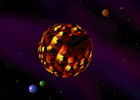 Behemoth is the ninth and last known planet of the solar system, and also the largest. It appears to be mostly orange, though it requires powerful telescopic equipment to have a fair chance at even seeing it. It has several moons, and was long believed to be made of solid rock. It is strongly associated with the element of Earth and hence is of special importance to the Sphere of Earth (Earth, Sphere of) of the College Esoterica. Behemoth is the ninth and last known planet of the solar system, and also the largest. It appears to be mostly orange, though it requires powerful telescopic equipment to have a fair chance at even seeing it. It has several moons, and was long believed to be made of solid rock. It is strongly associated with the element of Earth and hence is of special importance to the Sphere of Earth (Earth, Sphere of) of the College Esoterica. Access has been made possible by the Gateway Tower, and scouts have reported that Behemoth is actually a gaseous giant surrounded by a sparse "cage" formed by a network of mind-bogglingly long tunnels fashioned of stone and Sifran crystal. The tunnels themselves somehow support an atmosphere and gravity comparable to that of the surface of Sinai. Levels of Quantum Uncertainty are such that neither magic nor sophisticated technology is known to work here. In the Olympian Pantheon, Behemoth is also the name of a god of earth, the mountains, of metal-working, and of strength, depicted as a huge and muscular Kattha. | ||
| ||
| (obscure information outside of Ashdod and religious circles) Blakat is also regarded as the "Mad Goddess", and is strongly associated with insanity at times. At times, there have been attempts by outsiders to portray her favorably as a matron of soldiers, but this is contrary to the Babelite mythos, in that they see the universe as naturally chaotic and unfair, and thus their gods and goddesses are fundamentally flawed and are appeased more than truly worshipped. Blakat is depicted as a wild-haired, wild-eyed, mad-looking female Eeee with a fierce countenance, in torn clothes and pieces of mismatched armor, often carrying a cruel-looking weapon of exotic shape. She is frequently (but not always) depicted as having red hair and/or red fur; she is said to bathe in the blood of her enemies. Blakat is also the name of a mountain in the range of the "Seven Sisters" near Mount Dronnel, outside the city of Babel. It is home to a shrine devoted to her name, and it is said that every pebble on the mountain represents a drop of blood shed in her name. Priestesses of Blakat are taught some martial skills, and many of them serve as mercenaries for those who make especially large "donations" to the sisterhood. Of the Yodhblakat (Daughters of Blakat), many are trained to become the Slakash - the Poison Women - warrior priestesses who are best known for their practice of working themselves into berserk frenzies when entering combat. | ||
| ||
| (see Kuroko) | ||
| ||
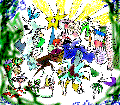 1) A large and distinctly bounded Forbidden Zone in a mountainous region bordering the northern lands of Chronotopia on the continent of Ai. Whereas many Forbidden Zones are simply a hazard to passing airships, this one exemplifies magic at its (hopefully) wildest, the land twisted into a nightmarish horror, where it is hard to tell what is a creature, what is a building, what is a plant, or what much of anything is with any degree of certainty, as it all tends to blend and warp together. 1) A large and distinctly bounded Forbidden Zone in a mountainous region bordering the northern lands of Chronotopia on the continent of Ai. Whereas many Forbidden Zones are simply a hazard to passing airships, this one exemplifies magic at its (hopefully) wildest, the land twisted into a nightmarish horror, where it is hard to tell what is a creature, what is a building, what is a plant, or what much of anything is with any degree of certainty, as it all tends to blend and warp together.Locations of note within Bosch's borders would include the Crystal Tower, the Plains of Change (and Citadel of Change), the Cascades of Fire ... and a lone oasis of relative safety, the monastery known as the "Sanctuary of Gears" (or "Sanctuary of Order") located on its western end, connected by a mountain pass to Gallis. 2) The language of the nation of Chronotopia, a fairly "industrialized" land on the surface of Sinai, on the northern part of Ai, bordering Titania, the Vykarin Wastes and Sylvania. As for why the language of Chronotopia would be named after its greatest enemy, only the monk historians of the Celestial Order might know for sure, but legends hint at a time when Bosch was not quite the land of horrors that it is now. | ||
| (Not common information outside of Nordika) Bosch is by no means a tourist location (except perhaps for the pilgrims to the Sanctuary of Order) but one of its sites more legendary to outsiders would be the Cascades of Fire, located near its border with Chronotopia, near the Living Gates. The Cascades look like numerous "waterfalls" of liquid fire, visible for a great distance across the blighted valleys of Bosch. It is believed that the touch of the Cascades can destroy even the most potent of magical devices, and hence some quests have been undertaken by Landsknechts or Knights Templar to have some evil artifact destroyed by dropping it into the Cascades. (Even if it weren't so, no one is likely to go fishing into the Cascades to retrieve it!) | ||
| ||
| (not common knowledge outside Babel and religious circles) One of the Sabaoth Seven, but not considered one of the original Sabaoth Six -- demon-warriors bound to the service of the ruler of Ashdod as well as the Seven Sisters. Chezek is depicted as the least imposing of the Sabaoth Seven, as a mutant Eeee with chibix-like features. (Considering that chibix bear at least a superficial resemblance to Eeee anyway, Chezek is basically depicted as an especially pathetic and comical-looking Eeee with a chitinous covering.) In tales in which Chezek is included, the chibix-Eeee has no combat abilities to speak of, and is a cowardly thief and spy for the group. Chezek is sometimes associated with Barada, since chibixes are sacred to her, but his habit of being a chatterbox who occasionally thoughtlessly blabs secrets does not endear him to his mistress. | ||
| ||
 Chibix are nocturnal quasi-arthropods that fly on somewhat bat-like wings, and feed on fruits and seeds, found scattered across the globe, though mostly in more temperate climates. They are shelled creatures that bear some remote resemblance to bats, and, indeed, in Rephidim Standard, when one refers to "bats" in the generic, if one is not referring to an Eeee, one is likely referring to one of these creatures. Chibix are nocturnal quasi-arthropods that fly on somewhat bat-like wings, and feed on fruits and seeds, found scattered across the globe, though mostly in more temperate climates. They are shelled creatures that bear some remote resemblance to bats, and, indeed, in Rephidim Standard, when one refers to "bats" in the generic, if one is not referring to an Eeee, one is likely referring to one of these creatures.While chibix wings are very fragile, the creatures themselves are shelled, and have some ability to regenerate (slowly), making them fairly hardy. They tend to be about the size of true bats, though there are rumors that in some regions they may reach truly legendary wingspans. In the Ashdod Territories, they are raised as a food staple by the Eeee. Chibix raised for food have their wings plucked - in part so that they cannot fly away, but also because a flightless chibix generally does nothing but sit and eat, and quickly its fatty hump grows significantly in size. Some Eeee nobles consider it a delicacy to pluck the pry loose the shell of a chibix and eat from its fatty hump, while the creature shrieks loudly, making a "pleasing" sound. Chibix with their wings left intact are sometimes kept as pets, though they are not known for being terribly bright. (And if they misbehave, they make a nice snack.) In myth, chibix often serve as messengers for the Goddess of Secrets, Barada. | ||
| ||
 According to Nagai myth and legend, the Chiga are demonic beings, resembling the serpentine Nagai, but possessing only a single clawed hand (and even this can melt away into the body, leaving the Chiga to look like a true serpent). The Chiga are malevolent and only occasionally "mischievous" beings, possessed of various strange powers, depending upon the story, with abilities such as invisibility, limited shape-shifting (typically into the forms of non-sapient, small creatures), and "phasing" through solid objects. Also according to legend, they are nigh-invulnerable, except when attacked with weapons made from the wood of a slightly rare tree found in the southern Savan, the Thistlebark Tree. According to Nagai myth and legend, the Chiga are demonic beings, resembling the serpentine Nagai, but possessing only a single clawed hand (and even this can melt away into the body, leaving the Chiga to look like a true serpent). The Chiga are malevolent and only occasionally "mischievous" beings, possessed of various strange powers, depending upon the story, with abilities such as invisibility, limited shape-shifting (typically into the forms of non-sapient, small creatures), and "phasing" through solid objects. Also according to legend, they are nigh-invulnerable, except when attacked with weapons made from the wood of a slightly rare tree found in the southern Savan, the Thistlebark Tree. The same name also applies to a type of jungle-dwelling insect (collectively "chigai" or "chigas") to be found in the Savan, well known for attacking the unwary in swarms, capable of bringing down small prey with their bites -- or being a considerable nuisance to larger foes. Sap from the Thistlebark Tree has properties in repelling and killing these pests, leading to much speculation about their relationship to the mythical "Chigai". Alas, it is unknown whether the name for the bug or the "demon" came first. | ||
 For ages, the City of Hands seemed to exist only in legend, a ruined city located somewhere in the Xenean jungles, overflowing with gems, but haunted by ghoulish spectres and strange phenomena where magic runs wild or is suppressed entirely. One particularly colorful notion about the city was that the buildings themselves are alive, able to sprout hands to catch the unwary, and that the buildings themselves could speak, telling secrets of old. For ages, the City of Hands seemed to exist only in legend, a ruined city located somewhere in the Xenean jungles, overflowing with gems, but haunted by ghoulish spectres and strange phenomena where magic runs wild or is suppressed entirely. One particularly colorful notion about the city was that the buildings themselves are alive, able to sprout hands to catch the unwary, and that the buildings themselves could speak, telling secrets of old. Eventually, the actual City of Hands was discovered by an expedition sponsored by the Rephidim Temple, but it was believed to be destroyed later. For a time, it served as a secret haven for escaped Savanite slaves, ruled over by a mutant leader alternately known as Third-Vision, Third-Eye, or Jezebel. Eventually, the City of Hands no longer maintained its secrecy, and openly proclaimed its existence as a place for free Savanites, but it was overrun in 6099 RTR by the forces of the Nagai Empire, and destroyed. In recent years, there have been attempts by the people of the newly formed independent state of Xenea to restore the City of Hands, though not necessarily to inhabit it again. Replicas of some of the more noteworthy structures of the City of Hands can be found in the port city of Safar, in the theme park known as Safarland. | ||
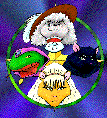 A legendary quartet of assassins, each of whom was associated with one of the four directions of the compass rose: Palao Alto, the Musician, of the North; Juniper Jade, the Philosopher, of the West; Lady Martinette, the Puppeteer (or the Consort), of the South; and Shikouju, the Sable Palm (or the Silver Blade), of the East. A legendary quartet of assassins, each of whom was associated with one of the four directions of the compass rose: Palao Alto, the Musician, of the North; Juniper Jade, the Philosopher, of the West; Lady Martinette, the Puppeteer (or the Consort), of the South; and Shikouju, the Sable Palm (or the Silver Blade), of the East.
| ||
| ||
 Some time ago, an Exile arrived on Rephidim, claiming to be part of a fellowship of paladins, of which he claimed to be the head of, and it was rumored that he also happened to be the sole member. He was resistant to any form of authority, and it's unclear just what this "order" stood for, except that its member(s) were warriors who supposedly had phenomenal magical powers as well. Some time ago, an Exile arrived on Rephidim, claiming to be part of a fellowship of paladins, of which he claimed to be the head of, and it was rumored that he also happened to be the sole member. He was resistant to any form of authority, and it's unclear just what this "order" stood for, except that its member(s) were warriors who supposedly had phenomenal magical powers as well.
| ||
| ||
| "Dagh" is a common curse word with origins that the average user of the name is not in the least bit aware of. The true origins have been lost to time, but "Dagh" figures into many legends as a "dark god" or "lord of the underworld", and generally as a very powerful and malignant entity. Some legends describe Dagh as a very powerful (and evil) wizard from a time in history closer to the Expedition, during the age that magic was supposedly first discovered on Sinai. "Dagh" also figures into colorful phrases and exclamations such as "Dagh's dentures!" or names of forboding locations, or strange rock formations, such as "Dagh's Tower". Somewhat controversially, Dagh is also recognized as the name of a recently discovered eleventh planet in the Primus System, associated with the Sphere of Illusion (Illusion, Sphere of). However, an explorer dubbed the planet "Quicksilver", and since this name is not considered a foul word in any known language or culture, it is often used as an alternate name for the world. Presently, little is known of this planet, save that it is accessible through the Gateway Tower and that it appears to be a reflective orb. | ||
| ||
| (not common information outside of Babel and religious circles) Dinala ("Love"), according to the myth of the Birth of the Seven Sisters, was the former name of the eldest of the Seven Sisters, before they rebelled against their father, the creator god Bael, killed him, and took his power. After that, she became the Goddess of Pleasure, Inala. Historically, there is evidence that Dinala was in fact worshipped as a love goddess in Babel's earlier history, often seen as a "fertility goddess", and the festivals in which she was worshipped at times grew into overblown, drunken parties. Eventually, the concept of "Dinala" was transformed into "Inala" ("Pleasure"). Of course, this is not anything that would be acknowledged by the Yodhinala ("Daughters of Inala" -- or priestesses of Inala), and would be considered blasphemy. | ||
| ||
| (not common information outside of Ashdodite and religious circles) Diphath is a lesser Babelite deity who is likely a precursor of the better known Goddess of Vengeance, Rephath. She is not recognized as part of the "Seven Sisters", and in the present-day Babelite mythos, Diphath figures into the scheme sometimes as a lesser, seperate goddess. However, the most "official" version of her story, and the one taught by Yodhrephath, goes something like this:
One day, word came to Diphath that the Goddess of Vengeance, with her huntswomen and her horribs, was crossing Diphath's lands. The Countess sent word to her armies, and plotted an ambush for the Goddess, before the Grey Warrior could reach her stronghold and threaten her. Diphath gathered all her people, and timed her blow carefully, so that Rephath was surrounded when they struck. The armies of Diphath swarmed over the huntswoman, howling and screaming for blood and death, and they slew many of Rephath's forces. But the Goddess herself was not so easily defeated. She rallied her remaining people behind her banner, and carved a path through the lines of the trap. Once she escaped, she brought her people in to harry the armies that had assaulted her, striking again and again, without warning, without sign, until the last Eeee soldier was dead or fled, and she had Diphath herself cornered and dismounted. "Countess," Rephath told the woman, "You are a fool, and you have spent your armies for naught. I only crossed your lands that I might visit my own temple on this mountain. Had you let me alone, I would have done no offense to you or yours. But now that you have drawn my ire, I will see all that you have and all that you are destroyed." Diphath, her wings broken and her body bleeding from a hundred wounds, wept and pled for her life. But the Goddess showed her no mercy, and dispatched her to her Sister, Death. She razed the dead Eeee's stronghold to the ground, leaving only a ruin of blasted rocks and a single broken statue to mark the place where once Diphath had reigned. The ruin she left, that all might take it as a warning of the consequences of crossing Rephath, and she cursed it, so that none would dare to settle there and so undo her warning, or come to offer tribute to Diphath's name. Although this tale purports to be of a time "before the Sabaoth," the first known recorded instance of it is little more than a thousand years old, making it unlikely that it refers to an actual event or person. Stories with older roots describe Diphath as a goddess, and scholars tend to believe that the "mortal woman" story was invented by Yodhrephath as part of a campaign to squash the dwindling cult of Diphath. (Suggesting such to a Yodhrephath, or any believer in the Sisters, however, would be inadvisable, to say the least.) It has been simply put that, where as Rephath represents "Do unto others as they have done unto you," Diphath's credo could be "Do unto others before they do unto you." The word "diphath" in Babelite roughly translates into a concept of "decisive first strike": taking action against an enemy before that enemy can be allowed to cause harm. Whether or not the danger presented by the enemy is real or imagined is hardly of any concern. Diphath may have once had a greater following, as evidenced by ancient shrines to her name that can still be found amidst the towers of Babel, in outlying territories, and the most famous -- though believed cursed -- one on Mount Rephath itself, but she has largely fallen by the wayside. Most present-day worshippers of Diphath see her as an independent, lesser goddess, having no particular connection to the Seven Sisters. In Babel, the few worshippers of Diphath usually keep their activities secret for fear of persecution, but in the surrounding countryside, some pockets of open worship remain. In depictions, Diphath has little established as to her personal appearance. She is shown as a female Eeee with head hair cut short, and no particular establishment of what her hair, fur or eye coloration should be. It's believed that the legend of her being a blood-drinker predates the story of her as a mortal woman, though there is some debate among scholars as to a matter of cause and effect: Does Diphath consume blood because this is a practice abhorrent for a modern-day Babelite Eeee? Or, is it because Diphath is depicted as drinking blood, that such a practice now has a negative stigma? Or could it be that the two are unrelated? | ||
| ||
| Mount Dronnel is a very large mountain located near the city-state of Babel in the Ashdod Territories on the continent of Ur. It is home to a wide variety of plants that yield roots and herbs that serve as components for many healing unguents ... and for several quack recipes as well. It holds a significant position in the mythology of Babel and in Eeee culture abroad, (The stories tend to be familiar even to Rephidim-born bats.) as many an arduous quest to the mountain despite hazardous weather has been required for some obscure component to a cure to aid an ailing hero, according to the tales. Some tales attribute the name of the mountain to being that of a great hero of old, but studies suggest that the recognized name (which is likely to have undergone change over the millenia) of the mountain may predate such legends. | ||
| ||
| (not common knowledge outside Babel and religious circles) One of the Sabaoth Seven, and also accepted as one of the original Sabaoth Six -- demon-warriors bound to the service of the ruler of Ashdod as well as the Seven Sisters. Ephasto is depicted as a mutant Eeee with eep-like features, easily the most grotesque of the Sabaoth Seven, with a disjointed, almost comical body characterized by bizarre proportions, a tiny head, and enormous, bugged-out eyes, with a vestigial beak. Ephasto is sometimes associated with Zakaro, though eeps are not particularly sacred to her. He is particularly bizarre in that his sole attack of note is to explode in a burst of bone shrapnel to fight the enemy. (The characters in these tales seem to be completely oblivious to the easy supposition, therefore, that Ephastos isn't going to get out of any battle alive, and if Ephastos shows up in a tale again after making this attack, no explanation is given for his miraculous return.) | ||
| The "First Ones" are believed to have been a race or collection of races who settled on Sinai long ago (millenia or even millions of years ago), and who had an extremely advanced civilization in terms of technology and magic. What became of them is a mystery, but there are still ruins to be found on the surface which are attributed to them. In Rephidim-dominated society, they hold god-like status in the popular mythology, and many pledges are made "by the First Ones". | ||
| The term "Flying Khattaman" is basically the Sinai equivalent of a "Flying Dutchman" from Earth lore. In a purely naturalistic sense, it refers to a phenomenon in which, usually during heavy precipitation, a viewer on board a sea-borne vessel will see a reflection of the vessel he or she is on, but, due to angling, it usually appears to be in the air, seeming like a ghostly flying craft. Some air sailors have reported similar phenomena of seeing "ghost airships", which may be attributed to a similar natural phenomenon, or else to various odd effects of Forbidden Zones. This term is also used to refer to an airship that has, for whatever reason, been abandoned and set adrift. Most airships left so abandoned will not stay aloft for very long untended, since the gas will eventually seep out, or else the ship will eventually fall prey to various airborne predators or scavengers -- be they wild animals, or pirates. | ||
| ||
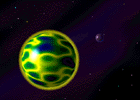 Fortunatis is officially considered the sixth planet from the sun, although in truth its orbit is highly irregular, thus throwing off attempts at accurately assigning numeric positions to the nine known planets of the solar system. Its appearance changes wildly as well, in color and (if one has rare telescopic equipment), surface pattern, as viewed from Sinai. Fortunatis is officially considered the sixth planet from the sun, although in truth its orbit is highly irregular, thus throwing off attempts at accurately assigning numeric positions to the nine known planets of the solar system. Its appearance changes wildly as well, in color and (if one has rare telescopic equipment), surface pattern, as viewed from Sinai. Fortunatis is one of the worlds that has been visited through the Gateway Tower, and it is reported that its surface does indeed change regularly, and it is deemed so unstable that it has been declared quarantined by authority of the Rephidim Temple. (The Kampfzengruppe and the Khattan Emirate are more in a position to have authority over the Gateways, but it seems that they have agreed with the Temple's assessment on this matter, as no further expeditions have gone there, to anyone's knowledge.) The planet is strongly associated with matters of luck and fate and is a factor in all sorts of popular attempts at telling portents of the future. Its "official" name changes regularly, as determined by the Sphere of Chaos (Chaos, Sphere of), to which it has special meaning. However, since the average citizen isn't able to or interested in keeping up with these seemingly random name changes, it is commonly known as "Fortunatis". Fortunatis is also one of many names for the god of luck (good and ill) and wealth, in the Olympian Pantheon. Fortunatis is often depicted as a "trickster god", though in myth he seems to compete with Ariel for this role. | ||
| ||
| (not common knowledge outside of Babel and religious circles) According to the myth of the Birth of the Seven Sisters, this name (which can be roughly translated as "Health" or "New Life") was the former name of Gorphat, Goddess of Affliction, before she and her sisters rebelled against and slew Bael, the Creator God. | ||
| ||
 Golems are rare manifestations of some of the more powerful magic to be found on Sinai -- animated constructions of various elements created by accomplished mages to do their bidding. These beings have no self-awareness, and are therefore capable of great feats of "bravery", having no care for their own (usually very short) existence. Consequently, they're typically phenomenally stupid as well ... though some are rumored to possess something of the intelligence and perhaps even personality of the mage that created them. Golems are rare manifestations of some of the more powerful magic to be found on Sinai -- animated constructions of various elements created by accomplished mages to do their bidding. These beings have no self-awareness, and are therefore capable of great feats of "bravery", having no care for their own (usually very short) existence. Consequently, they're typically phenomenally stupid as well ... though some are rumored to possess something of the intelligence and perhaps even personality of the mage that created them.
| ||
| ||
| (obscure information outside of Ashdod, or religious circles) (alternate spelling: Gurphat - guhr-FAHT) Sacrifices are made to her in hopes of staving off disease, or in the hopes of bringing it to the households of enemies. Due to the habit of her priestesses of conducting Purges in the Undercity, she is also associated with the Sphere of Fire (Fire, Sphere of) in some myths. Gorphat is also the name of a mountain outside of Babel, where a shrine to the goddess of the same name is located. Some of the priestesses practice magic of a sub-set of the Sphere of Life (Life, Sphere of), focusing on the aspect of Disease. | ||
| [not common knowledge outside Nordika] In Titanian lore, "gremlins" are mischievous spirit creatures that are responsible for the failure of machines. According to Titanian beliefs, gremlins live in greater numbers in areas of magic -- such as Bosch -- but they can only jump so high, so there are not as many of them that can reach the sky islands, such as Rephidim ... which explains why machines work better there. Basically, gremlins are just an anthropomorphization of the phenomenon of quantum uncertainty. | ||
| ||
| (not common knowledge outside Babel and religious circles) One of the Sabaoth Seven, and also accepted as one of the original Sabaoth Six -- demon-warriors bound to the service of the ruler of Ashdod as well as the Seven Sisters. Greve is depicted as a mutant Eeee with grabbit-like features, including a wild and hairy mane, multiple arms, and multiple eyes, as well as a spider-like tail from which the monster can spin webs or create a silken whip. Greve is often associated in these tales with Blakat, but Greve is also depicted as something of a nuisance to Blakat, for he does not merely steal things but -- like a grabbit -- is compelled to leave something in its place. | ||
| ||
| Gronegk (not common knowledge outside Babel and religious circles) One of the Sabaoth Seven, and also accepted as one of the original Sabaoth Six -- demon-warriors bound to the service of the ruler of Ashdod as well as the Seven Sisters. Gronegk is depicted as a mutant Eeee with grok-like features, including natural semi-organic armor, eyes hidden under a chitinous "helmet", an almost skeletally thin waist, and oversized forearms and legs, with armored wings, savage fangs, and wickedly curved claws. Gronegk is sometimes associated with Rephath, as her temple typically keeps kennels of sacred hunting groks. Like a grok, Gronegk has keen senses and is the tracker of the group, and lets out a bloodcurdling scream when he has found his prey. | ||
| ||
| ( see Gorphat ) | ||
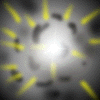 [Earth Time: November 5] Guy Fox Day is a not-quite-official holiday celebrated in Rephidim City, commemorating the legendary attempt of an Exile Fox would-be assassin to blow up the Captain-Astromancer ... but who set off the explosions prematurely, taking care of himself in the process. The holiday, due to its quasi-official status, is typically celebrated by a parade that goes through the Bazaar region, rather than through the city proper (though it is common for the Temple Scouts to be involved in the festivities.) [Earth Time: November 5] Guy Fox Day is a not-quite-official holiday celebrated in Rephidim City, commemorating the legendary attempt of an Exile Fox would-be assassin to blow up the Captain-Astromancer ... but who set off the explosions prematurely, taking care of himself in the process. The holiday, due to its quasi-official status, is typically celebrated by a parade that goes through the Bazaar region, rather than through the city proper (though it is common for the Temple Scouts to be involved in the festivities.)It is a time of fireworks, most notably involving flammable effigies of Foxes, either made of paper mache, or (the more expensive varieties) being stuffed animals with fur hides ... stuffed, that is, with fireworks, with the tail serving as a fuse. | ||
| Large lake in Titania. According to legend, a Titanian lost his hammer in the lake, and thereafter when he was asked where his hammer was, he would point at the lake and say, "There's my hammer!" And so it came to be known as Hammer Lake. | ||
| ||
| (not common knowledge outside Babel and religious circles) One of the Sabaoth Seven, and also accepted as one of the original Sabaoth Six -- demon-warriors bound to the service of the ruler of Ashdod as well as the Seven Sisters. Hosheb is depicted as a mutant Eeee with horrib-like features, including chitinous natural armor, multiple arms ending in pincers, a tail with a poisonous stinger, large insect wings, mandibles, and multiple eyes. Hosheb is sometimes associated with Gorphat, since horribs are sometimes associated with the spreading of affliction. | ||
| ||
| [Olympian Lore] In Olympian legend, Ikara was a female Solus or else a Kattha who had bargained with a mage to gain wings, who had become obsessed with the Sun God Primus, and failed to gain his notice - for he was a god, and she a mere mortal. She flew so high, chasing after the Sun God in his flaming sky-ship, that she drew too close and caught aflame, plummeting to the ground. In later, more popular versions of the tale, the gods had mercy on Ikara and raised her from the ashes anew, and she now can be seen on occasion, chasing after the sun, observed as a phenomenon known in other cultures as a "sun dog". Thus, she is often associated with the imagery of rebirth and of the phoenix. Also the name of a town in Olympia, where a shrine has been built to Ikara next to a small temple of Primus. There, Ikara is revered as a goddess, albiet not of the original pantheon. | ||
| ||
| (obscure information outside of Ashdod, or religious circles) Inala is also the name of a mountain just outside of Babel, and home to a "shrine" to the goddess of the same name -- in practice, a brothel where all manner of vices are performed, many of them quite unspeakable. The "Children of Inala" are priests and priestesses born and bred into the service of this goddess, and cannot leave the priesthood except by death. It is a whispered rumor that those who are born to the "Children" who are ugly or deformed in any way are offered up as sacrifices. Those who are not "perfect" but still "usable" are sold off to the various Houses as child servants. | ||
| ||
 (plural: kuroko; alternate name: bokuru) (plural: kuroko; alternate name: bokuru)(Not common information) Kuroko are, according to the legends passed down amongst mages of the Sphere of Spirit, ghost-like beings with semi-substantial forms, capable of affecting and being affected by physical matter to some degree. They are often associated with the undead, but not believed to be truly spirits of the dead themselves. In fact, certain powerful Necromancers are purported to be able to create these quasi-intelligent entities to do their bidding, provided they can maintain control over them. These monsters are also known as the "puppeteers". | ||
| ||
| The Lake of Langour is an inland sea located on the northern part of the continent of Ai. Regional legend holds that the "underworld" (the land of monsters and spirits) has a lake that matches the Lake of Langour in exact dimensions, and that the lake, therefore, exists both in the physical and spiritual realms. This is often used as an excuse to explain mysterious disappearances of fishing vessels that set out on the lake, though a more naturalistic explanation would be that there are sometimes freak storms that may catch a fishing vessel unawares, and Sinai is also known to have a number of seaborne hostile creatures that could present a risk to a small boat. | ||
| ||
| (Not common knowledge outside Half Valley area and scholarly circles) According to myth, the Levitha River (largest river of the Seaborne Reach) was created by a gargantuan two-headed sea serpent that lives under the ocean. Purportedly, this serpent -- known as Levitha -- laid down in the Half Valley, creating indentations that formed the river. Accordingly, the river has tributaries that correspond to the arms of this gargantuan Naga-like creature, and it also has two mouths into the Sea of Himaat. Levitha also figures prominently in other myths indigenous to the region, and is prominent in naming of geological features (especially those of large size). | ||
| ||
 Logos is the eighth planet from the sun, a brown world that is not visible to the naked eye, but only with the help of powerful (and rare) telescopic equipment. It is associated with and important to the Sphere of Mind (Mind, Sphere of) of the College Esoterica. Since the advent of travel to other worlds by way of the Gateway Tower, it has been determined that Logos is a gaseous planet, and the Tower provides access to a satellite orbiting the planet (apparently built by the Sifras), rather than to the planet itself. Logos is the eighth planet from the sun, a brown world that is not visible to the naked eye, but only with the help of powerful (and rare) telescopic equipment. It is associated with and important to the Sphere of Mind (Mind, Sphere of) of the College Esoterica. Since the advent of travel to other worlds by way of the Gateway Tower, it has been determined that Logos is a gaseous planet, and the Tower provides access to a satellite orbiting the planet (apparently built by the Sifras), rather than to the planet itself. In the Olympian Pantheon, Logos is also the name of the God of Knowledge, also deemed a God of Wisdom, though there is some discrepancy in myths as to whether Logos or Primus would be the wisest of the gods. (In fact, there are a number of myths in which they engage in contests to determine which one is the wiser.) | ||
| ||
| (Not common knowledge outside of Nordika) Legendary underground kingdom of a bygone age, with borders supposedly matching that of present-day Kroz. Ruins can be found in the wilderness of Kroz, attributed to this ancient culture of a kingdom supposedly ruled by Skreeks. Some adventurers and treasure-hunters are drawn to Kroz in hopes of finding one of these entrances, and fighting off monsters and traps in order to retrieve ancient treasures, but the known entrances have pretty much been picked over by now. | ||
| ||
 Morpheus is the second planet from the sun, appearing grey in color, when it can be seen, and also curious in that it always appears to be in the same "phase" of crescent. This is because, even though it is closer to the sun, somehow it is on the same plane of orbit as Sinai, and also has the same length of year, thus moving in concert with Sinai. It is associated with the realm of Dream and hence is of importance to the Sphere of Dream of the College Esoterica. Morpheus is the second planet from the sun, appearing grey in color, when it can be seen, and also curious in that it always appears to be in the same "phase" of crescent. This is because, even though it is closer to the sun, somehow it is on the same plane of orbit as Sinai, and also has the same length of year, thus moving in concert with Sinai. It is associated with the realm of Dream and hence is of importance to the Sphere of Dream of the College Esoterica. In legend, Morpheus is also the name of the God of Dreams, without any specific form (though, due to the predominance of the Olympian mythos, traditionally portrayed as a grey-furred Kattha). However, there has been a recent rebirth of interest in the long-forgotten God of Dreams, as several Dream Mages have claimed to have seen Morpheus during their rituals. This God of Dreams is described as appearing as a dark silhouette in the shape of a winged Khatta with large ears. In recent years, the Gateway Tower provided access to the planet Morpheus. The Rephidim Temple began attempts to map the planet, but this was frustrated by its everchanging nature. Reports indicate that the planet has a breathable atmosphere despite having a low gravity that shouldn't be able to sustain it. Furthermore, it is covered in grey silt which drifts about in clouds, requiring some sort of air filter to be worn while on the planet. Strange structures of "molten crystal" and stone rise and fall on occasion, and sometimes defy gravity, while the air is filled with the quiet sounds of chiming melodies from time to time. Further exploration has been frustrated by a large crystal growth that formed about the Gateway Tower on Morpheus, effectively trapping it, and preventing exit from the Crystal Chamber there. | ||
| ||
| (not common information outside of Ashdod Territories) Goddess worshipped by the golden-furred feline Gigis of the Gigi Coastal area, depicted as an idealized Gigi female. | ||
| [not common knowledge outside of Nordika] "Overlords" are believed to be the most powerful entities in the Forbidden Zone of Bosch, and often figure into the mythos of cultures in the Nordikan region. They are deified as dark gods, or -- more often -- demonized in those theologies that center around the "Great Gear" or the "Star". Some believe that the Overlords are another type of Degenerate ... persons who were once living beings, but who ventured into Bosch. While these Overlords may have been consumed by Bosch and may very well be unable to leave its boundaries, the belief is that these individuals were strong-willed enough to master the wild magicks of Bosch, and to exert their influence over the Imps and Degenerates dwelling there -- making themselves lords with near god-like powers over their limited domain. It is also believed that some scattered dark societies might actually worship these Overlords as gods, and might actively serve them, seeking the downfall of "mundane" society and the expansion of the wild zone of madness that is Bosch. | ||
| Although there are many pantheons of gods and goddesses worshipped on Sinai, "The Panthon" typically refers to a number of gods and goddesses of the mythology of the nation of Olympia, in the region of Nordika. The primary members of the Pantheon equal twelve, each one corresponding with a different Sphere of Magic (see Magic, Spheres of), and all of them depicted as felines. These gods consist of:
| ||
| ||
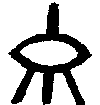 Paradys has long been legend among the Vartans, a sky island that would appear, then disappear into some Forbidden Zone, making pursuit impossible, supposedly made of gold and crystals and other shiny things. Thus, it was only natural that this should be the subject of the final quest of an old Vartan hero, Shokar, and the crew of his airship, "Shokar's Silver Bell". Paradys has long been legend among the Vartans, a sky island that would appear, then disappear into some Forbidden Zone, making pursuit impossible, supposedly made of gold and crystals and other shiny things. Thus, it was only natural that this should be the subject of the final quest of an old Vartan hero, Shokar, and the crew of his airship, "Shokar's Silver Bell". | ||
| In the Early Expedition Era, a large country of Savanites in what is now the territory of Xenea had its capitol in the City of Hands, located in a canyon along the Xenean River. The ruler of these Savanites was known as "Priest-King", signifying his position as both religious and political leader of these people, and ancient records suggest that he was a mage as well - though these suppositions are still considered to be highly controversial, especially within what remains of the Nagai Empire. At some point, this "Savanite Empire" collapsed, and over the years, the formerly ruling Savanites became slaves to those races their ancestors had once enslaved. In recent years, however, the City of Hands was rediscovered, and a settlement of escaped Savanite slaves formed there, choosing a woman known alternately as "Jezebel", "Third-Vision" or "Third-Eye" as their leader, as a new "Priest-King". (Sometimes, this is translated as "Priest-Queen", but the original hand-sign is gender neutral.) 5 New Year of 6103 RTR, Xenea became an independent territory, with its capitol situated in the port city of Safar, its first recognized ruler being Priest-Queen Jade-Eyes (also known as "Azhtar"), sister of the former Priest-Queen. | ||
| ||
 Primus is one of the many names ascribed to the sun, a yellow star, of the solar system of which Sinai is a part. It is also the name of the rune associated with the Sphere of Light. Primus is one of the many names ascribed to the sun, a yellow star, of the solar system of which Sinai is a part. It is also the name of the rune associated with the Sphere of Light.
| ||
 Sinai lacks for any moon, but it does possess a ring, which is known to Rephidim culture as "The Procession". From the ground, it appears as a long trail of "stars" which move ever so slightly faster than the real ones behind them across the night sky. Some of the larger "travellers" figure strongly in astrology in many Sinai cultures. Sinai lacks for any moon, but it does possess a ring, which is known to Rephidim culture as "The Procession". From the ground, it appears as a long trail of "stars" which move ever so slightly faster than the real ones behind them across the night sky. Some of the larger "travellers" figure strongly in astrology in many Sinai cultures.The ring is so named because ancient myth holds it to be a procession of the recently departed souls making a pilgrimage to the land beyond the stars. The larger points of light follow fairly consistent orbits (despite frequent collisions with smaller chunks of space debris) and have been attributed with names corresponding to major persons of history long past -- the names having survived much longer than the memory of what exactly made the owners of them worthy of such immortality in legend. These "guides" are held to remain forever in the Procession, leading the way to the lands beyond. | ||
| ||
| (obscure information outside of Ashdod and religious circles) Rephath is a matron of vigilantes, and myths involving her of course deal with matters of revenge, being routinely quite violent. At times, officials of Ashdod have attempted to portray Rephath in a more positive light as a matron of law enforcement officials, but this is only done by completely ignoring the particulars of established mythos. Rephath is traditionally depicted as a grey female Eeee - idealized as with most Babelite goddesses - with hair bound back in a long braid, and dyed markings in her fur, including variations upon her personal rune. She is often shown holding a set of scales, typically tipped to one side, and she is also often depicted with a large, double-bladed axe. | ||
| ||
| (not common knowledge outside of Babel or religious circles) According to the myth of the Birth of the Seven Sisters, this name (which means "mercy" in Babelite) is the former name of Rephath, Goddess of Vengeance, before she and her sisters rebelled against and slew Bael, the Creator God. | ||
| ||
| (not common knowledge outside Babel and religious circles) According to popular Babelite myths such as The Birth of the Seven Sisters, Rinala (sometimes translated as "Life", "Immortality" or "Perpetual Life") was the name of the goddess who eventually became Sunala ("Death") when she and her sisters rebelled against and murdered the creator-god, Vael. However, less well known is that there are some theories that Rinala was in fact a predecessor of sorts to the pleasure goddess Inala -- That, long ago in Babel's history, two deities formed a sort of creative/destructive duality, one (Rinala) representing life, and the other (Sunala) representing death. The festivals of Rinala were concerned with fertility and life, and traditionally became intertwined with rituals of courtship, a practice that eventually caused the festivals to be more associated with love -- to the point that the concept of Rinala was originally changed into Dinala ("Love"). From there, the festivals built around the celebration of love turned into hedonistic binges, and what evolved from that was that the goddess of "Love" eventually became Inala ("Pleasure"). Priestesses of Inala would, of course, find this history of the development of their religion to be utterly blasphemous, and this is not anything taught openly in Babel about the origins of their goddesses. | ||
| ||
| (not common knowledge outside Babel and religious circles) One of the Sabaoth Seven, and also accepted as one of the original Sabaoth Six -- demon-warriors bound to the service of the ruler of Ashdod as well as the Seven Sisters. Rugharo is depicted as a mutant Eeee with rughrat-bull-like features, particularly having impressive musculature and phenomenal strength, with a very small head and two beady little eyes, and curled ram's horns. Some versions show him with four arms (giving him six limbs like a real rughrat), but this is a less common depiction. Rugharo is sometimes associated with Inala, though rughrats are not particularly sacred to her. He is the strongest of the Sabaoth Seven, but also quite possibly the stupidest (though he has some rivalry for this latter distinction). | ||
| ||
| A great Rokuga warrior of the Nagai Empire of a time past. His life history has achieved mythical proportions, and though his feats as a warrior were said to be great, ultimately he is remembered for how he purportedly met his end. In the Nagai Empire, the power of the Emperor-Potentate is supposed to be boundless, and every once in a while this is demonstrated as he chooses to grant a boon to some hero who has won his favor. In theory, the recipient of this boon should be able to ask for anything. If ever a boon was asked and not granted, such a thing is not spoken of. Even this story is one that is never spoken of in the presence of a member of the Emperor-Potentate's court. Ryubushi was one great warrior who won the honor of being brought before the Emperor-Potentate and allowed to ask a boon. Ryubushi, as brave and accomplished as he was, was also overly ambitious (and none too bright). He asked that he become Emperor-Potentate. According to myth, the Emperor-Potentate of that time swallowed Ryubushi immediately. By way of explanation, he proclaimed that the boon had been granted -- Ryubushi would now have the honor of becoming Emperor-Potentate by becoming one with his body through digestion. The moral of the story, of course, is not to abuse such a boon. | ||
| (not common knowledge outside Babel and religious circles) In the legend of the Sabaoth Seven, a young Sabaoth quested in the Nether Realms in order to prove himself, and faced seven demons, each of whom was a combination of Eeee and some dumb beast indigenous to the lands of Ashdod. He outwitted or outfought each of these creatures, and enslaved them to serve as guardians of the throne of Ashdod. There are some variations in this myth that suggest that it may predate the rule of the Sabaoth, and instead was applied to some legendary (and possibly fictitious) ruler of old. Near as can be told, the earliest versions of this story actually only had six demons. It was later that each demon was associated with a different goddess, giving each demon the dual role of protecting the ruler of Ashdod, and also serving the Seven Sisters. Tales involving the Sabaoth Seven vary greatly in tone. In some tales, they are heroic, one by one giving their lives to preserve the Sabaoth or some favored servant of his. In others of more recent composition, they are more comical than useful, existing solely to be defeated by some foe, who then in turn is smitten by the Sabaoth himself. Chezek is the least fearsome of the group, and seems to exist only as a jester-type of character in the myths. Here is a listing of the demons, and the goddess each is sometimes associated with.
| ||
| (not common knowledge outside Babel and religious circles) An alternate version of the legend known as the Sabaoth Seven. (Some versions of the myth do not include Chezek, who seems to be a later addition to the story.) | ||
| ||
| Legend had it that the Sabaoth was immortal, and "Sabaoth" therefore was both name and title. While he was the "king" of Ashdod, there was no queen. Still, there are yet many who can claim to be a son of Sabaoth ("bar Sabaoth"). Since the Sabaoth was considered to be immortal, this implied no succession by heritage as it would in many other kingdoms. The Sabaoth's history was long shrouded in mystery, and few were those who would get to see him except at a great distance. He was not completely secluded, however, for he made daily appearances on a daily basis for the ceremony of the Greeting of the Sun. His mortality is now evident, however, as the Sabaoth was slain in an uprising after the great defeat Ashdod suffered in the War of the Plaguebringers. He was succeeded by the High Prince Boghaz (his biological son), but was not long after murdered, and replaced by his wife, Saraizadze, who was dubbed the High Princess. It looks as if a tradition of calling the leader of the land the "High Prince" or "High Princess" is being set here, though it is not yet demonstrated whether this rule will be passed on in hereditary fashion. (In Babelite politics, it is likely that the throne will find a new successor by blood -- shed rather than inherited.) | ||
| This is a term used in the Khattan Emirate to refer to the Procession at night. Namely, the Procession (a ring around Sinai) appears to be split into two parts at night, as Sinai's shadow is cast on the ring. The shorter section is known as the Dagger, while the longer one is known as the Scimitar. As the night progresses, the "Dagger" gets longer, while the "Scimitar" shortens, until the two switch places. | ||
| ||
| ||
| ||
| Red moon of the planet Abaddon. Although devoid of any native plant life, Sheol has been reported to have a breathable atmosphere, another product of Sifran terraforming, since the planet is not large enough to sustain a gravity sufficient to keep an atmosphere of its own. Sheol is home to a moon base supported by the Abaddonians, fortified in recent years in an attempt to defend against an attack that was believed to be destined to come from the Silent Ones under the leadership of a heretical leader known as "Light-of-Star". Sheol is also the name of a lesser deity of the Olympian Pantheon, associated with death and ashes. | ||
| ||
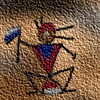 The theology of the Hekoye centers around their god, Shung Matu, who is seen as less than benevolent, more of a prankster god who seems to delight in bringing misery to his creations. However, the Hekoye accept all of this with reservation of passion, as their lot in life. Even those who master the magical arts of Sinai, they believe, are not spared from the trickery of Shung Matu. The theology of the Hekoye centers around their god, Shung Matu, who is seen as less than benevolent, more of a prankster god who seems to delight in bringing misery to his creations. However, the Hekoye accept all of this with reservation of passion, as their lot in life. Even those who master the magical arts of Sinai, they believe, are not spared from the trickery of Shung Matu.
| ||
| [Not common knowledge] There are legends that speak of the Silent Ones -- ancient ancestors of the cheetah-like Savanites, who predate even legends of a great Savanite Empire in the distant history of Sinai. The Silent Ones supposedly had great cathedral-ships that ferried them across the stars, and ruled a celestial empire, before they came down to Sinai. Their culture was one that revered the Star as a deity ... but portrayed this entity in a more warlike aspect. | ||
| ||
  Sinai is the fourth planet from the sun in the Primus System, and is close to being Earth-like in its variation of climates and its ability to sustain life. Sinai is slightly larger than Earth, for comparative purposes, but also somewhat lighter, due to a very low amount of heavy metals present. Sinai lacks a moon, though it is surrounded by a ring known to most Sinai-based cultures as the Procession ... and some theories hold that it may well be the remnant of a moon that was destroyed long ago by unknown forces. Sinai is the fourth planet from the sun in the Primus System, and is close to being Earth-like in its variation of climates and its ability to sustain life. Sinai is slightly larger than Earth, for comparative purposes, but also somewhat lighter, due to a very low amount of heavy metals present. Sinai lacks a moon, though it is surrounded by a ring known to most Sinai-based cultures as the Procession ... and some theories hold that it may well be the remnant of a moon that was destroyed long ago by unknown forces. Among so many other odd features, Sinai is characterized by floating "sky island" structures, the largest of which is capable of sustaining Sinai's most powerful city, Rephidim. Magic is known and practiced on Sinai, and it is known that magical powers (and a phenomenon known as "quantum uncertainty) are stronger near the surface, but weaker up at the level of sky islands. They are sometimes even more powerful in certain regions, such as a Forbidden Zone. At the same time, where magic is more powerful, machinery -- especially more complex mechanisms -- tends to be less reliable. A wide variety of creatures can be found on Sinai, including many sapient races so varied as to defy organized classification -- particularly due to the high incidence of mutation on the surface, and the occasional arrival of Exile races from other worlds. Most of the surface is covered by oceans, but there are three major land mass groups: Ai, Ur and Lamu. The sky islands drift freely across the globe, following varying courses, most not bound to any particular continent or other geographical anchor. | ||
| ||
| (not common knowledge outside Babel and religious circles) One of the Sabaoth Seven, and also accepted as one of the original Sabaoth Six -- demon-warriors bound to the service of the ruler of Ashdod as well as the Seven Sisters. Skekos is depicted as a mutant Eeee with skedat-like features, including a chitinous black body and smooth, featureless faith, with sharp spines protruding all over, and segmented barbed whips extending from each forearm. Skekos is sometimes associated with Sunala in tales that attempt to tie the Sabaoth Seven to the Seven Sisters, but skedats are not particularly sacred to Sunala. Like a skedat, Skekos tends to charge blindly at an opponent, hoping to impale the foe upon his spikes, and to flail with his barbed whips. | ||
| ||
| [not common information outside Babelite religious circles] The name "Srinala" is a blending of the Babelite words for Life (Rinala) and Death (Sunala), to make a hybrid word that implies a state of both at once. This is distinctly different from the concept of "undeath", or, that is, animated corpses produced as a result of necromancy, or found in the form of "ghosts" and "revenants". In Babelite history, there have been claims of "miraculous" births, whereby a child would be born to the Eeee who was essentially comatose, forever sleeping, yet still living. Whatever historical basis there might be for such stories, the tradition has evolved that Life Magic has been used by "hedge wizards" amongst the Sunala priesthood to see to it that an Eeee child is born in the image of Sunala. Traditionally, this means having black fur, white head-hair, and pupil-less white eyes. (This would imply that the child so born is blind.) Also traditionally, the child's wings are shredded, preventing flight, and in the fashion of sacrificial maids who are compelled to hurl themselves off of cliffs or tall buildings. Sometimes, the child is born in a comatose state, and is declared to be "Srinala" - both a title and name, for such a child born this way is not permitted to be known by any other name. Such a child is incapable of caring for herself, and is generally supported by magical means as well as dedicated care. She is considered to be a good omen and a bringer of blessings to the village ... or, perhaps more accurately, a boon to turn away curses from Sunala upon the village. At some point during young adulthood, the Srinala is to be sacrificed during a fortuitous alignment, usually as part of a magical ritual, to bring some sort of favor upon the people (or, again, to turn away curses). It is unthinkable that a Srinala should be allowed to turn old, or - more likely - to die of natural causes. Srinala also occupy another role in the worship of Sunala, in that it is believed that they lack souls and therefore may serve as a vessel for the souls of the departed to inhabit, before they are taken into oblivion at last by Sunala. In the presence of a priestess, a Srinala may speak, purportedly possessed by a departed spirit, and offer counsel to the living. (College Esoterica writings on this phenomena subtly suggest that this may be an application of Life Magic to use the Srinala like a puppet of sorts, or perhaps that the priestesses may dabble a bit into other spheres of magic in order to get the desired result.) Beyond speaking, however, the Srinala is never supposed to be animate in any other way, for it is believed that would compromise their unique position on the threshold between life and death. | ||
| ||
 Alternate spelling: Stalwirlund Alternate spelling: Stalwirlund Minor kingdom on the surface, once ruled by the line of Xante, south of the Nordika region, possibly near Half Valley on the Seaborne Reach. It fell into in-fighting a few generations ago, and even in its height had limited contact with the outside. It was reported to have limited use of technology or magic, and had no clearly dominant species in its population. According to legend, this was the site of the conflict between King Xante and Lord Calderas, in which the Compass Rose was rumored to have been called in to deal with a confrontation over the minor fiefdom of Gessershire -- and in which the Compass Rose also purportedly met its doom. Given the legends that have sprung up around the Compass Rose over the years, there are some who hold that the land of Stalwirland is fictitious. Some of the fiefdoms believed to make up Stalwirland included Gessershire, Xanashire (site of the king's estate, Falcon's Watch), and Tectishire. | ||
 "The Star" figures as an entity or "all-powerful force" in various religions found on Sinai. Just because someone gives lip-service to "the Star" does not mean that they believe in the same "Star" as someone else. Even in Rephidim culture, dominated by worship of the First Ones, the "Star" gets tribute as a vaguely-defined force for good. The "Star" referred to in the texts of the Order of the Bounded Star and Anchor (the Knights Templar) is thought of differently -- as a moral entity and deity, with actual motivations and taking action in the lives of mortals. The "Star" worshipped by many (but not most) Savanites appears to be more akin to the latter version, though its worship is often influenced by tribal rituals. The existence of the "Star" as a facet in Rephidim worship (and the offshoot of "technology worship" to be found in the technopriesthood) illustrates the ill-defined nature of Rephidim Temple theology, as the function of the Temple of a governmental body is given precedence over its existence as a religious authority. "The Star" figures as an entity or "all-powerful force" in various religions found on Sinai. Just because someone gives lip-service to "the Star" does not mean that they believe in the same "Star" as someone else. Even in Rephidim culture, dominated by worship of the First Ones, the "Star" gets tribute as a vaguely-defined force for good. The "Star" referred to in the texts of the Order of the Bounded Star and Anchor (the Knights Templar) is thought of differently -- as a moral entity and deity, with actual motivations and taking action in the lives of mortals. The "Star" worshipped by many (but not most) Savanites appears to be more akin to the latter version, though its worship is often influenced by tribal rituals. The existence of the "Star" as a facet in Rephidim worship (and the offshoot of "technology worship" to be found in the technopriesthood) illustrates the ill-defined nature of Rephidim Temple theology, as the function of the Temple of a governmental body is given precedence over its existence as a religious authority.
| ||
| ||
| (obscure information outside of Babel and religious circles) Despite her role, Sunala is depicted as a beautiful woman (by Babelite standards), with beauty rivaling that of her older sister, Inala. In Babelite myth, Sunala is the only goddess of the seven that is spared from ever being subjected to getting killed off at the hands of the others. It is suspected that if someone were to introduce a story that did portray Sunala as dying, he or she would receive a personal visit from some priestesses of Sunala intent on purging this "heresy". Sunala is also the name of a mountain located outside Babel, which houses a shrine to the goddess of the same name. It is not much of a secret that the priestesses of Sunala are often hired to perform ritualistic assassinations, though their services generally do not take them outside of Babel itself, and they never act against the ruling house of Babel (i.e., the Sabaoth, the High Prince, the High Princess, or whomever might hold the throne). | ||
| The large and forboding thistlebark trees of the Savan look much like any other tree, but their bark sports sharp, wickedly-curved spines that ward off herbivores (and woodsmen). The wood of these trees is semi-porous, and overall not very useful, except that it is purported that these trees have some sort of natural properties that disrupt certain aspects of magic. Many Naga legends hold that weapons fashioned of the wood from a thistlebark tree are capable of harming Chigai (the Naga equivalent of a "demon") and other wicked spirits normally impervious to the physical realm. Among mages of the Sphere of Spirit, this wood is sought after as a component in some more potent (and expensive) rituals, and some Naga lords will surround their grounds with thistlebark trees, believing it to be an effective ward of spells of scrying (as well as a hazardous deterrent to trespassers). | ||
 [Obscure information only known to a select few] [Obscure information only known to a select few]According to ancient myths associated with ideas that the Savanites might have actually once had an empire of their own, rather than always being slaves and savages, they were ruled by a Priest-King, who was supported by a circle of Priest-Mages known as the Twelve, who were, in turn, supported by the Twelve-Times-Twelve. These mages represented the twelve known Spheres of magic, and were responsible for training others of their kind in the ways of spellcasting on Sinai. | ||
| ||
| (not common knowledge outside of Babel and religious circles) Vael is associated with the destroyer/earth goddess of the myth of the Birth of the Seven Sisters, and is seen as a "dead goddess", incapable of answering prayers. She is seen as the mother of the Seven Sisters, and, according to many myths, murdered by Bael, the creator/sky god, and responsible for urging the Sisters to rebel against and kill their father. Even though Vael is regarded as "dead", she is sometimes referred to as being responsible for earthquakes, and in some outlying provinces, she is still worshipped as an earth goddess, sometimes taking on a duality of her own in being responsible for both life and death. | ||
| ||
| Saint Varcharious of the Hand, historically, was a Gallee of the House of Kelsie, and a captain in Rephidim's Air Fleet, who lived sometime circa 3700 RTR. His was a tragic story of rebellion against the Captain-Astromancer during the War of the Golden Realm, and reconciliation at the end. | ||
 The Sphere of Water is one of the twelve Spheres of magic recognized by the College Esoterica. Its mages often dress in green (signifying the ocean), its identifying rune is "The Wave", and the planet of Ashtoreth is of interest to celestially-minded mages of this Sphere. The Sphere of Water is one of the twelve Spheres of magic recognized by the College Esoterica. Its mages often dress in green (signifying the ocean), its identifying rune is "The Wave", and the planet of Ashtoreth is of interest to celestially-minded mages of this Sphere.Spells of this Sphere deal with, as would be expected, water in its various forms -- including rainstorms and ice. | ||
| ||
| ||
| ||
| (obscure information outside of Babel, or religious circles) Zakaro is also the name of a mountain outside of Babel, which holds a shrine deciated to the goddess of the same name. Many of the priestesses of Zakaro are mages, focusing on the Sphere of Chaos. For the most part, the priestesses of Zakaro do not have approval from the College Esoterica, but they have traditionally been protected by Babelite law for their roles as priestesses. | ||
| ||
| (not common knowledge outside of Babel and religious circles) Can be translated as either "Soul" or "Wisdom". According to the myth of the Birth of the Seven Sisters, this was the former name of Zakaro, Goddess of Sorcery, before she and her sisters rebelled against and slew Bael, the Creator God. |
| Home Page |
Player Guide |
Log Library |
Recent Logs |
|---|---|---|---|
| Encyclopedia |
Dramatis Personae |
Art Gallery |
Moz Ezley Asylum |